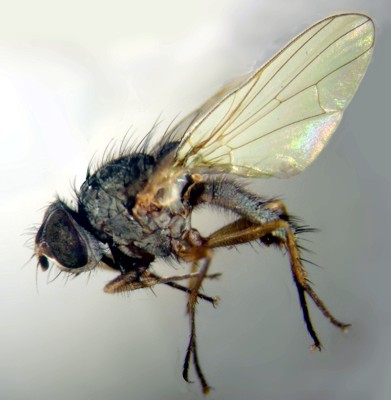Pests
Pegomyia hyosciami Panzer. - Beet Fly, Beet Leaf Miner
Systematic position.
Class Insecta, order Diptera, family Anthomyiidae, genus Pegomyia. P. hyosciami is a sibling species to P. betae Curtis and P. mixta Villeneuve. K.Yu.El.berg (1970) in his key has given diagnostic characters for the first two species, but they were not distinguished in Russian applied literature until 1976.Biological group.
Pest of Chenopodiaceae and Solanaceae cultural plants.Morphology and biology.
Imago yellowish-gray with brownish stripes on mesonotum and with one brown median stripe on abdomen; the latter stripe sometimes dotted (body length 5-6 mm). Two basal antennal segments reddish-brown; 3rd antennal segment and apical half of palpi brown; antennal arista bare. Legs usually yellow, all femora or only anterior ones brownish, tarsi black. Male eyes are divided by narrow frontal strip, which is wide in female. The species is similar to P. betae. They differ in morphology of male and female genitalia. Male genitalia are pale in P. hyosciami; cerci are light at base; their outer lobe is strongly expanded at base, with weak hooks; inner lobe is somewhat shorter, subtriangular, convex. Female abdominal segment VIII has three weakly chitinized sclerites; central one is emarginated, cordate, without welt at base; almost triangular lateral sclerites are poorly visible. Egg is white, elongate-oval, with reticulate surface sculpture consisting of fine hexahedral cells and low costulae. Egg side adjacent to a plant is smooth. Egg length is 0.87 mm. Larva pale yellow, with wrinkled cuticle, narrowed anteriad; thickened posteriorly, with ring of conic processes along margin of last segment (body length 7.5 mm). Puparium oval, ocher-brown to reddish-brown, becoming brown just before emergence of fly; 4.5-5 mm long. Flies winter in puparia. Female lays eggs on the lower surface of leaves of beet or other plants, placing them by rows with several eggs in a row. Its fecundity is 40 to 100 eggs. In 2-5 days after oviposition, hatching larvae gnaw through the lower leaf cuticle and penetrate into pulp. Eating parenchyma, the larva gnaws out a cavity (mine) in a sheet plate, not breaking upper leaf cuticle. Being narrow in the beginning of larva life, the hole gradually becomes wider. The damaged sheet plate looks translucent and bubble-shaped on outer side. Development of larva lasts 7-22 days. Mature larvae go out of a leaf and go in the ground where they pupate. Larvae of summer generation pupate more often inside their leaf mines. Phase of pupa lasts 13-30 days.Distribution.
The species is known from Northern America and Europe. In Western Europe, P. hyosciami penetrates into more southern areas, in contrast to P. betae. The two species have not been distinguished in Russian applied literature until recently. The literature data show wide distribution of P. hyosciami in the USSR; however, these records may belong to P. betae or P. mixta, as well. Joint inhabitancy of two or three species is established in some regions. For example, two species have been met on beet in Nizhnii Novgorod Region, both Root Fly and Beet Fly damaged beet, but P. betae prevailed (Berezkina, 1968). In the USSR, Pegomya flies are widely distributed in all beet-growing zones to Murmansk Region in the North, in the Nonchernozem zone, Ukraine, Caucasus, Transcaucasia, Central Asia (up to a height 3500 m in eastern Pamir), in Siberia and the Far East. In the majority of regions, the species structure of Pegomya flies is not defined.Ecology.
The species has 3-4 generations in Ukraine, 4 in Central Asia, Kazakhstan, Rostov Region, 2-3 in the Moscow, Leningrad, Smolensk, Vologda, and Grodno Region, 2 generations in Nizhnii Novgorod Region, Baltic States, Cis-Baikalia, and Eastern Siberia. The number of generations depends mainly on temperature, air humidity, and light day length. Reduction of the light day length with simultaneous rise of temperature promotes the increase of diapausing larvae in northern areas of the USSR. Flies appear in spring at air temperature 11°C and higher and ground temperature 10°C (with a threshold 5°). Degree day sums necessary for the beginning of imago flight are 156-219° (air temperature) and 69-89° (ground temperature). Females require additional food. They lay eggs May-June. Mass oviposition coincides with appearance of 2nd-3rd pairs of the true leaves of beet. The developmental cycle embraces 34-46 days in the first generation. The increased number of the pest on beet plants is marked at a distance of no more than 50-75 m from field margins. A predecessor and adjacent crops do not influence the fly spreading in beet fields. The main cause for drying eggs is relative air humidity 83% or less, combined with air temperature +25-30°C and higher. The fly population density is regulated by oviphages and braconids (Opius) destroying in some years 50-60% of eggs and larvae of the pest.Economic significance.
As against P. betae, the P. hyosciami is considered a wide polyphage damaging about 26 species of host plants belonging to 6 families; i.e., Chenopodiaceae (beet, spinach), Solanaceae (goose-foot, jimson weed, benbane, belladonna), Hirrosastanaseae (chestnut), Amarantaceae, Portulacaceae, Aizoaceae. Damaged leaves turn yellow and dry up. Larvae requiring additional food abandon drying leaves and crawl to fresh ones. Control measures include agronomical actions promoting fast growth of culture, destruction of weeds, deep autumn plowing. Chemical ones are insecticide treatments in the period of oviposition every 7-8 days, beet seed dressing.Reference citations:
Berezkina M.I. 1968. Two species of beet mining flies. Zashchita rastenii 8: 55 (in Russian).El.berg K.Yu. 1970. Antomyiidae. In: Bei-Bienko G.Ya., ed. Keys to insects of the European part of the USSR. V. 5(2). Leningrad: Nauka, p. 458-511 (in Russian).
El.berg K.Yu. 1981. Antomyiidae. In: Narchuk E.P. & Tryapitsyn V.A., eds. Insects and mites . pests of agricultural plants. V. 4. Hymenoptera and Diptera. Leningrad: Nauka: 188-198 (in Russian).
Rogochaya E.G. 1974. Antomyiidae. In: Vasil.ev V.P. ed. Pests of agricultural crops and forest plantations. Kiev: Urozhai, v.2: 540-548 (in Russian).
Saiko V.F. 1976. Beet mining flies. Moscow: Kolos, 88 p. (in Russian).


